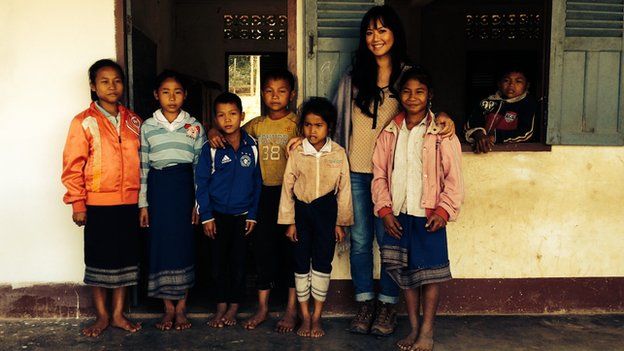Inside Laos: A US beauty queen's quest for change
- Published

More than three decades ago, Amy Chanthaphavong's parents fled their home country of Laos.
Her father had been a fighter pilot in the Laos air force, supporting the Americans in their war on neighbouring Vietnam.
As communists tightened their grip on Laos, he decided it was time to leave.
Fearing punishment from the country's Marxist-ruled administration, he decided it would be too dangerous ever to return to the country of his birth.
But 35 years later, his daughter Amy made a life-changing decision.
She left San Diego, California, for the small South East Asian country of Laos, intent on becoming part of its rapid economic development.
Economic revival
As one of the world's last few remaining communist states, Laos was closed off to much of the world until the 1990s, when reforms started being introduced to tackle severe poverty.
It is still one of the poorest countries in East Asia. But over the last decade its economy has been growing rapidly - by up to 8% a year thanks to the construction of huge hydroelectric dams and a boom in commodity exports.
However, its people remain predominantly poor and unskilled.
Amy's mission is to help change that.
Culture of storytelling
Against the advice of her family, who still fear for her safety in Laos, she left the US with big plans.
"Some people grow up knowing they want to be doctors, engineers and astronauts - I just wanted to help Laos, " she says.
Amy had already garnered attention after becoming the first Lao-American woman to be crowned Miss Asian America in 2009.
And that success only intensified her pride in the country of her roots and her desire to return there.
She began by making films, and soon realised that storytelling in all its forms would be the key to change.
Her short films, featuring personal stories of Laotians, focus on how non-profit organisations and the government are trying to lift people out of poverty and encourage economic development.
By giving people a platform to share their stories, Amy says she hopes it encourages others to be "authentic and be vulnerable and not to be ashamed of their past, regardless of what it is."
"When you film someone's life, it takes [on] a life of its own and it becomes something even more beautiful," she says of her short films.
"I believe in the power of sharing stories. I think that anyone, whatever they've accomplished in life or not, has a story to tell," Amy says of her first film, which focused on a non-profit group building schools in Laos.
"Sharing one's fears, vulnerabilities, and overcoming challenges makes us more real and human to each other in this digital world," she says.
Storytelling is important in Lao culture, says Amy, as it was means of passing down traditions, religion and culture to the next generation.
"Besides books and search engines, the most I learned about Laos came from stories told by my parents, grandparents, aunts and uncles," she says.
"Laos has a strong tradition of folklore. It is not a culture that focuses on logic, reasoning and intellect, but one which is heavily driven by emotional intelligence. Stories are the best way to draw out and convey emotions."
During her day job as chief strategy officer for Muanson Media, a local media company, Amy advises locals and companies on things ranging from how to utilise social media, to helping musicians get paid for their art.
Tackling challenges
However, sharing stories about the challenges facing the small developing country is not easy.
In September, the communist government began to regulate social media and Amy decided to take down her short stories website, "I Am Amarai".
"I figured it may be safer for me to lay low," she says, explaining that the government's ban on online criticism of its policies made her reflect on how to continue her work.
But now, she plans to take a different tack.
In June, she intends to release a film made in partnership with the Ministry of Energy and Mining, thereby avoiding the risk of government disapproval.
The film focuses on bringing sustainable energy to rural parts of the country and is based on a project funded by independent think tank, Global Institute for Tomorrow (GIFT).
Despite Laos achieving a high electrification rate - about 85% of the population now has access to electricity - the improvement has not had a marked influence on economic development, according to GIFT.
A quarter of the population still lives below the poverty line.
Eugenia Fabon Victorino, Asean economist at ANZ Research, says this is because the Lao government has focused on generating hydro power for export, rather than boosting the country's manufacturing sector.
She argues that the latter would have been more helpful to poor people.
"If you compare the manufactured exports of Laos in 2003 to 2013, the percentage of those exports has gone down tremendously," she says.
"We all know that it is the manufacturing sector that would generate most employment."
Mistrusting change
Meanwhile, Amy believes her gentle storytelling approach will help tackle problems in all sorts of areas, including education, health, inequality and urbanisation.
"For Laotians, change doesn't come easy - so anything new - you don't always trust it right away."
Locals find it quite bizarre that a Lao American should move to Laos, says Amy. Many locals want to travel in the opposite direction, in search of a better life.
"Locals look at me like an alien, wondering why Miss Asian America has moved to Laos.
"I have purpose in what I am doing, and as hard as it is in Laos on a daily basis, this adventure has already been one amazing ride."
- Published18 April 2023